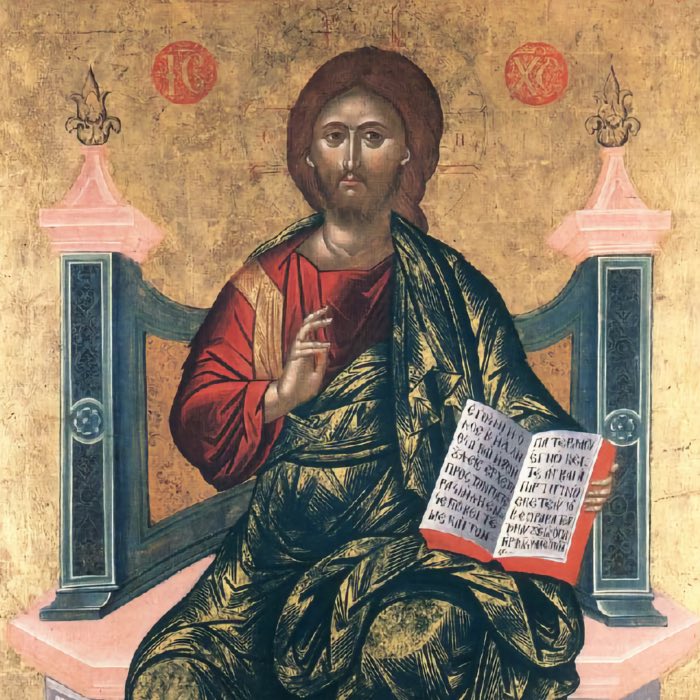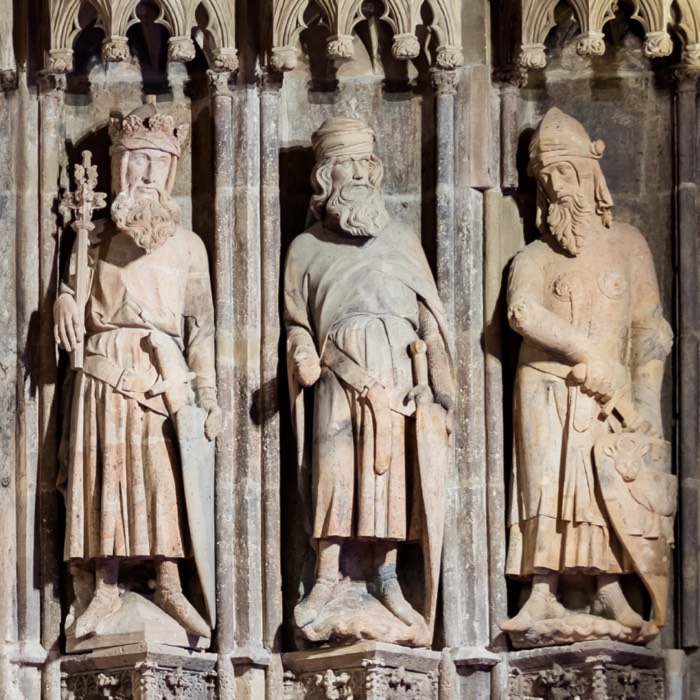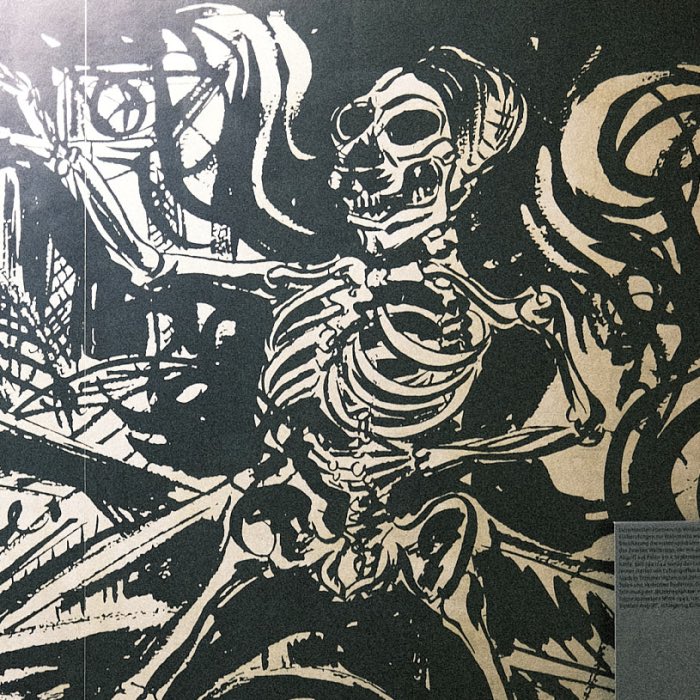Roman origins of the Cologne Carnival
As the clock strikes 11:11 AM tomorrow, the so-called ‘Fifth Season’ begins in Cologne. The city is overrun with revelers, and the streets are bustling with people. The citizens of Cologne celebrate with unrestrained joy and, notably, a fair amount of alcohol. But where does Carnival actually come from? What are its origins, and how has it evolved over time? This post takes you on a brief journey through the history of the Cologne Carnival to shed light on the cultural background of the festival, which tends to be forgotten in today’s thoroughly commercialized carnival.
 Detail from The Lupercalian Festival in Rome by Adam Elsheimer (more details below). Source: Wikimedia Commonsꜛ (license: public domain)
Detail from The Lupercalian Festival in Rome by Adam Elsheimer (more details below). Source: Wikimedia Commonsꜛ (license: public domain)
Roman origins
The Cologne Carnival traces its roots back to Roman times. The region, part of the Roman Empire, absorbed various Roman winter festivals. These festivals were celebrations not just of winter’s end but also expressions of veneration for various gods and the reawakening of nature. The customs introduced by the Romans in the territories they conquered, including present-day Cologne, gradually blended with local Germanic (and later Christian) traditions. This fusion laid the groundwork for what would evolve into the modern Cologne Carnival.
Saturnalia
One of the key festivals that influenced the tradition of the carnival was Saturnalia, in honor of the Roman god Saturn. This festival, held in mid-December, was characterized by a reversal of social order. It began with a sacrifice at the temple of Saturn, followed by a public feast. During Saturnalia, public institutions were closed, and temples organized public banquets.
It was customary to exchange gifts during Saturnalia. The celebrations included private feasts with sometimes excessive eating and drinking, where satirical poems and riddles were recited. Roman citizens shed their formal togas in favor of comfortable tunics and wore Pillei, felt caps typically worn by freed slaves, symbolizing a temporary egalitarianism.
A central figure of the festivities was the Saturnalicus princeps (Lord of Saturnalia), also referred to as rex bibendi (King of Drinking), highlighting the increased consumption of wine during the festival. This period also officially sanctioned dice games for money and the lottery of festival gifts, known as apophoreta.
Notably, moral constraints were significantly relaxed during Saturnalia. The “suspension” of class differences was a crucial aspect of the festival. Slaves were treated as equals by their masters, and in some cases, roles were humorously reversed, with masters serving their slaves. The exchange of gifts ranged from small tokens to valuable items, further emphasizing the festival’s spirit of generosity and equality.

Dice players in a wall painting from Pompeii. Source: Wikimedia Commonsꜛ (license: public domain)
During the celebration of Saturnalia, the Romans used oscillum, which were representations of human heads, as a symbolic substitute for actual human heads. Source: Wikimedia Commonsꜛ (license: CC BY-SA 3.0)
Lupercalia
Lupercalia, celebrated in mid-February, was dedicated to Faunus, the god of fertility. This ancient festival, purportedly established by either Romulus or Evander, served as a purification and fertility celebration. Held on February 15th, as spring approached, the day was known as dies februatus, a day of atonement. The archaic customs observed in Rome until late antiquity suggest a focus on the purification and fertilization of the land, the city, its inhabitants, and their herds.
The festivities began with a goat sacrifice in the Lupercal (a sacred grotto in Rome), followed by a sacrificial meal. During the ritual, two noble young men were brought forth and touched on the forehead with the bloody knife used in the sacrifice. Their blood was then wiped off with wool soaked in milk, and the young men were expected to laugh, possibly symbolizing atonement or recalling older human sacrifices.
After the meal, the priests, known as Luperci, clad only in the skins of the sacrificed goats around their waists, would cut other skins into strips. They then ran through the city, likely around the Palatine Hill, wielding these strips. Married women willingly placed themselves in their path, hoping to be struck on the hand with the strips, as it was believed to bring marital blessings and enhance fertility.
These purification rites, involving the sacrifice of goats and dogs, symbolized not only fertility but also cleansing. Young men, garbed only in animal skins, would traverse the streets, touching bystanders with leather strips as a symbol of promoting fertility.
 The Lupercalian Festival in Rome (ca. 1578–1610), drawing by the circle of Adam Elsheimer, showing the Luperci dressed as dogs and goats, with Cupid and personifications of fertility. Source: Wikimedia Commonsꜛ (license: public domain)
The Lupercalian Festival in Rome (ca. 1578–1610), drawing by the circle of Adam Elsheimer, showing the Luperci dressed as dogs and goats, with Cupid and personifications of fertility. Source: Wikimedia Commonsꜛ (license: public domain)
Bacchanalia
The Bacchanalia, festivals in honor of Bacchus, the god of wine, were also part of the Roman festive calendar. Characterized by unrestrained revelry, feasting, and dancing, these festivals were so wild and uncontrolled that they were later banned by Roman authorities.
Carnival elements
Masks and costumes were a significant aspect of these festivals. They allowed participants to conceal their identities and move outside of societal conventions. This element of disguise and role reversal was crucial for the development of the carnival.
Carnival in the Middle Ages
During the Middle Ages, the Carnival in Cologne underwent significant transformation. Its initial Roman roots progressively merged into the then evolving Christian Lenten traditions. This period of celebration now embraced rituals to drive away winter and indulgent festivities preceding the Lenten season of Easter. The earliest known written accountsꜛ of these celebrations date back to 1220, depicting scenes of feasting, dancing, dress-up games, and processions both on foot and horseback.
Managing the excesses of the Carnival proved to be a challenge. In 1341, the city council resolved to stop allocating funds from the municipal treasury for these festivities. Additionally, the council frequently enacted bans on various forms of masquerade in 1487 and repeatedly prohibited dressing up in pagan motifs and condemned public spectacles involving disguises of clerics, monks, or nuns throughout the 17th century.
 Detail from The Fight Between Carnival and Lent by Pieter Bruegel the Elder, 1559. Source: Frans Vandewalle (flickr)ꜛ (license: CC BY-SA 2.0). You can see the full painting hereꜛ.
Detail from The Fight Between Carnival and Lent by Pieter Bruegel the Elder, 1559. Source: Frans Vandewalle (flickr)ꜛ (license: CC BY-SA 2.0). You can see the full painting hereꜛ.
 Bartmann jug, Cologne 1530/65. For a long time, historians assumed that the expression ‘Alaaf’, used during Cologne Carnival, originated from the 18th century. This Bartmann jug proves that the word was used as a cheer or toast as early as 1550. In this context, the term means ‘Nothing is better than a good drink’. The jug was found during excavations on Streitzeuggasse Street. Seen at the City Museum of Cologne.
Bartmann jug, Cologne 1530/65. For a long time, historians assumed that the expression ‘Alaaf’, used during Cologne Carnival, originated from the 18th century. This Bartmann jug proves that the word was used as a cheer or toast as early as 1550. In this context, the term means ‘Nothing is better than a good drink’. The jug was found during excavations on Streitzeuggasse Street. Seen at the City Museum of Cologne.
18th century decline and 19th century revival
During the French occupation of the Rhineland, the authorities in Cologne prohibited the traditional Carnival celebrations in 1795, but reinstated them in 1804. While the bourgeoisie continued to enjoy masquerade balls, the street festivities of the Carnival had nearly vanished. Post the withdrawal of the French and the subsequent Prussian control from 1815, the Cologne Carnival experienced a revival and reorganization in 1823 with the establishment of the “Festordnendes Comité” (lit. Committee in charge of the event), which added a component of critique towards the foreign (Prussian) authorities, creating a “cultural-political stroke with a humorous ambiance.”
This first committee and the other carnival societies that were founded in the following years laid the basis of the modern Carnival in Cologne, with all its organized events, sessions and institutions such as the “Kölner Dreigestirn” (lit.: “Cologne Triumvirate”), which still exist today.
 A so-called “Krätzchen” of the “Roten Funken”, a typical headgear of the modern Cologne Carnival. The “Rote Funken” are one of the oldest and most traditional carnival societies in Cologne. Photo taken in the NS Documentation Center El-De Haus.
A so-called “Krätzchen” of the “Roten Funken”, a typical headgear of the modern Cologne Carnival. The “Rote Funken” are one of the oldest and most traditional carnival societies in Cologne. Photo taken in the NS Documentation Center El-De Haus.
Cologne Carnival in the Third Reich
In 1935, the Cologne Carnival officially opposed joining the Nazi-run “Kraft durch Freude” program, an act often referred to as the “Narrenrevolte” (“Rebellion of the Fools”). This resistance was primarily against the organizational integration rather than a stand against the Nazi ideology itself. Notably, several prominent figures within the Carnival community were already members of the NSDAP. During the early stages of Nazi rule, Jewish participants in the Carnival were subjected to antisemitic slander and persecution. This dark chapter of the Cologne Carnival was long and widely ignored in post-war Germany and only recently addressed.
 Anti-Semitic float from the 1934 Cologne Rose Monday parade. Source: NS Documentation Center Cologne.
Anti-Semitic float from the 1934 Cologne Rose Monday parade. Source: NS Documentation Center Cologne.
 Karl Küpper (1905-1970), a local celebrity in Cologne’s Carnival, frequently demonstrated his critical stance against the Nazi regime, until he was banned from speaking in February 1939 and ordered to report regularly to the Gestapo. He escaped further sanctions by enlisting in the Wehrmacht. Photo taken in the NS Documentation Center El-De Haus.
Karl Küpper (1905-1970), a local celebrity in Cologne’s Carnival, frequently demonstrated his critical stance against the Nazi regime, until he was banned from speaking in February 1939 and ordered to report regularly to the Gestapo. He escaped further sanctions by enlisting in the Wehrmacht. Photo taken in the NS Documentation Center El-De Haus.
Cologne Carnival today
Today, the Cologne Carnival stands as one of the largest and most famous street festivals in Europe. It is a celebration of cultural heritage, freedom, and joy. Officially commencing on the 11th of November at 11:11 AM and spanning until Ash Wednesday, with the main festivities around Rose Monday, the event encompasses a series of parades, balls, and stage shows, drawing millions of visitors from across the globe.
While its origins are rooted in Roman traditions, the festival has undergone significant transformation and secularization in modern times. Hijacked by Christian influence over the centuries, contemporary celebrations bear little resemblance to their ancient Roman origins. Today, the Carnival has evolved far beyond its initial scope, becoming a significant economic factor for the city. It injects a substantial financial boost into the local economy, as the influx of tourists during the Carnival season translates into considerable revenue.
This transformation of the Cologne Carnival can be seen as an example for the dynamic nature of cultural practices, which remain anything but static. It highlights how traditions are not only adopted and adapted over time but also how they can be repurposed to meet contemporary needs and contexts. The modern Carnival in Cologne, with its wide array of traditions and customs, stands as a unique cultural phenomenon – a blend of historical influences and current societal and economic factors. It’s a fascinating example of the fluidity and adaptability of cultural expressions over time.
 New monument to the Cologne Carnival on the banks of the Rhine in Deutz. In the background: Cologne Cathedral. Taken in September 2023.
New monument to the Cologne Carnival on the banks of the Rhine in Deutz. In the background: Cologne Cathedral. Taken in September 2023.
Cologne Carnival cheat sheet
This list acts as a ‘cheat sheet’ to help you get through the Carnival season in Cologne.
- Carnival (Karneval)
- The term “Carnival” comes from the Latin carne vale, meaning “farewell to meat.” It reflects the Christian tradition of fasting during Lent, where meat consumption is prohibited until Easter.
- Fastelovend
- The local Cologne term for the Carnival season. It translates to “fast evening” (Fastenabend).
- Fith Season (Fünfte Jahreszeit)
- The colloquial term for the Carnival season, lasting from Women’s Carnival to Ash Wednesday.
- Women’s Carnival (Weiberfastnacht or Altweiberdonnerstag)
- This tradition, taking place on the Thursday before Ash Wednesday, marks the beginning of the street carnival. It’s a day when women symbolically take control, reflecting a reversal of societal roles, reminiscent of Saturnalia’s societal inversion.
- Carnation Saturday (Nelkensamstag)
- The Saturday between Women’s Carnival and Rose Monday.
- Rose Monday (Rosenmontag)
- This is the highlight of the German Carnival, featuring large parades and celebrations. The name could be derived from the German dialect word “rasend”, “Rasenmontag” (raging Monday), reflecting the peak of carnival festivities. There is actually no direct Christian origin for this day.
- Shrove Tuesday (Veilchendienstag)
- The day before Ash Wednesday, it is the final day of the carnival, where people celebrate before the onset of Lent. In Cologne, several smaller parades take place in the city’s neighborhoods on this day.
- Ash Wednesday (Aschermittwoch)
- Ash Wednesday marks the end of the Carnival and the beginning of the 40-day fasting period of Lent in Christian tradition. People attend church services and receive ashes on their foreheads as a sign of penance.
- Lent (Fastenzeit)
- A 40-day period of fasting in Christianity starting from Ash Wednesday. It is a time of reflection and penance, drawing a parallel to the Roman days of atonement during festivals like Lupercalia.
- Alaaf
- A traditional Cologne carnival shout, meaning “Above all!”. This could be seen as a nod to the elevated social freedom and joyous spirit of the Roman festivals.
- Bützchen
- Cologne term for a small, cheeky kiss common during the carnival.
- Strüßjer
- Cologne term for a small bouquet of flowers that is gifted during the carnival.
- The 11th of November
- The official start of the Carnival season in the Rhineland at 11:11 AM on the 11th of November.
- Geisterzug
- A protest parade against the commercialization of the Cologne Carnival, taking place on the Sunday before Rose Monday. You can read more about this here.
References
- Wikipedia article on Cologne Carnivalꜛ
- rheinische-geschichte.lvr.deꜛ
- Die Historie des Kölner Karnevals (Stadt Köln)ꜛ























comments